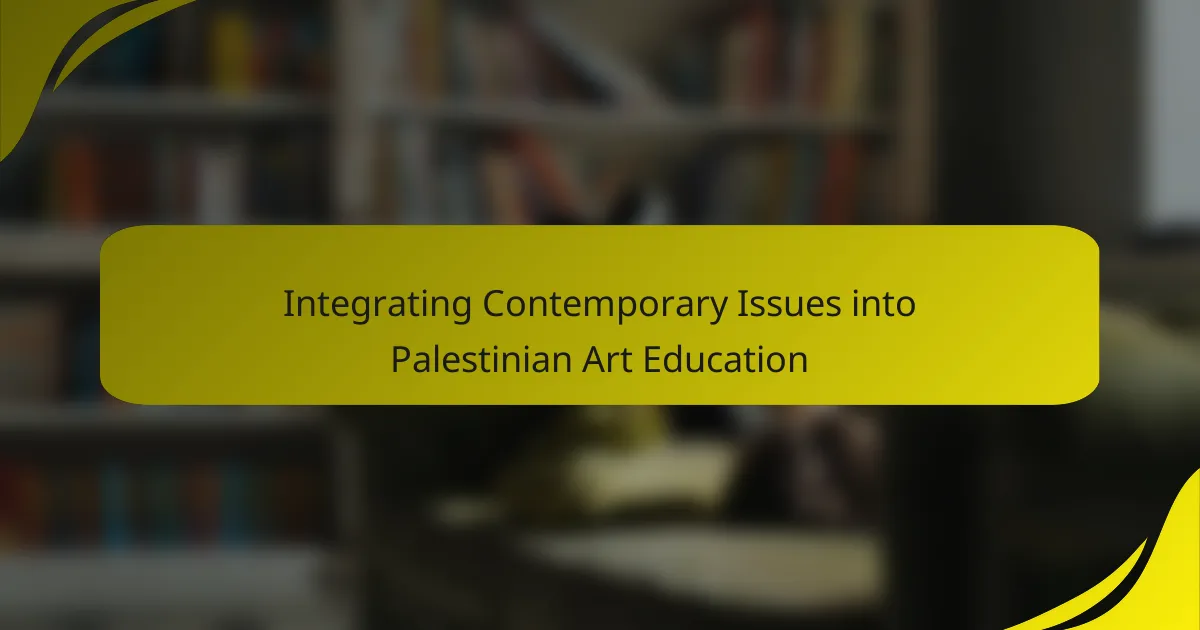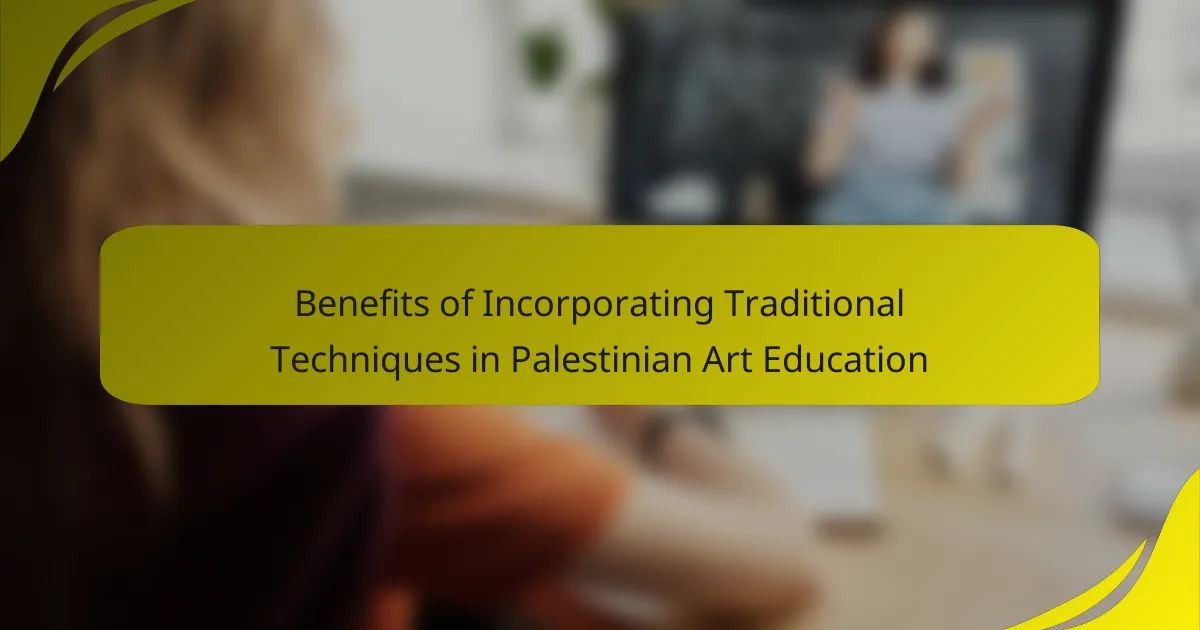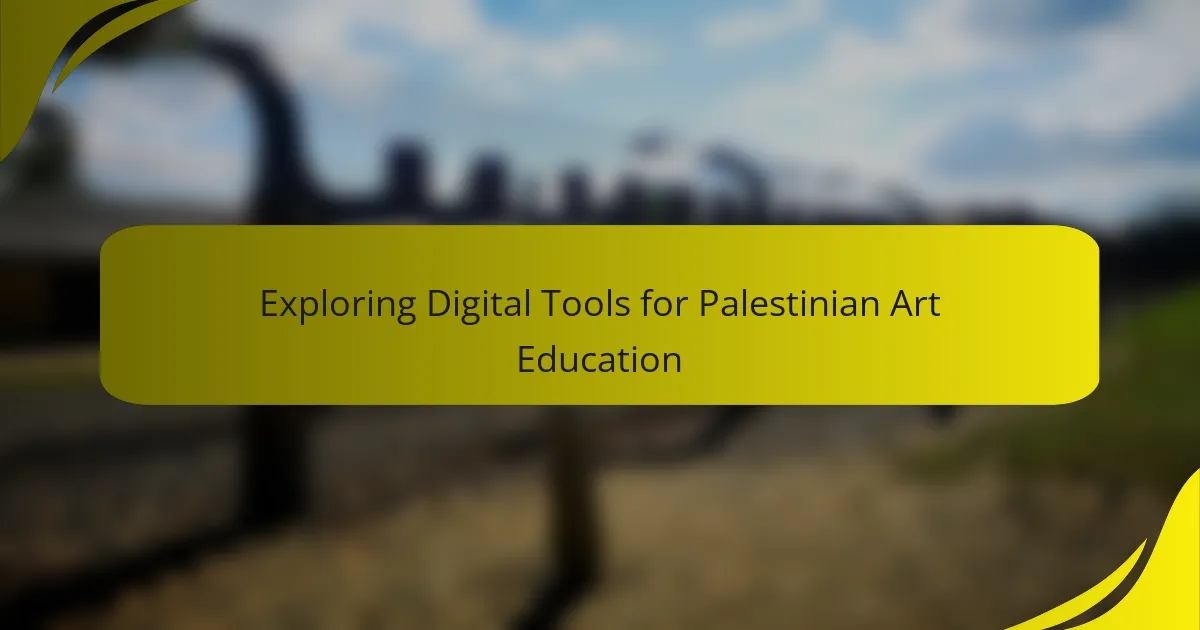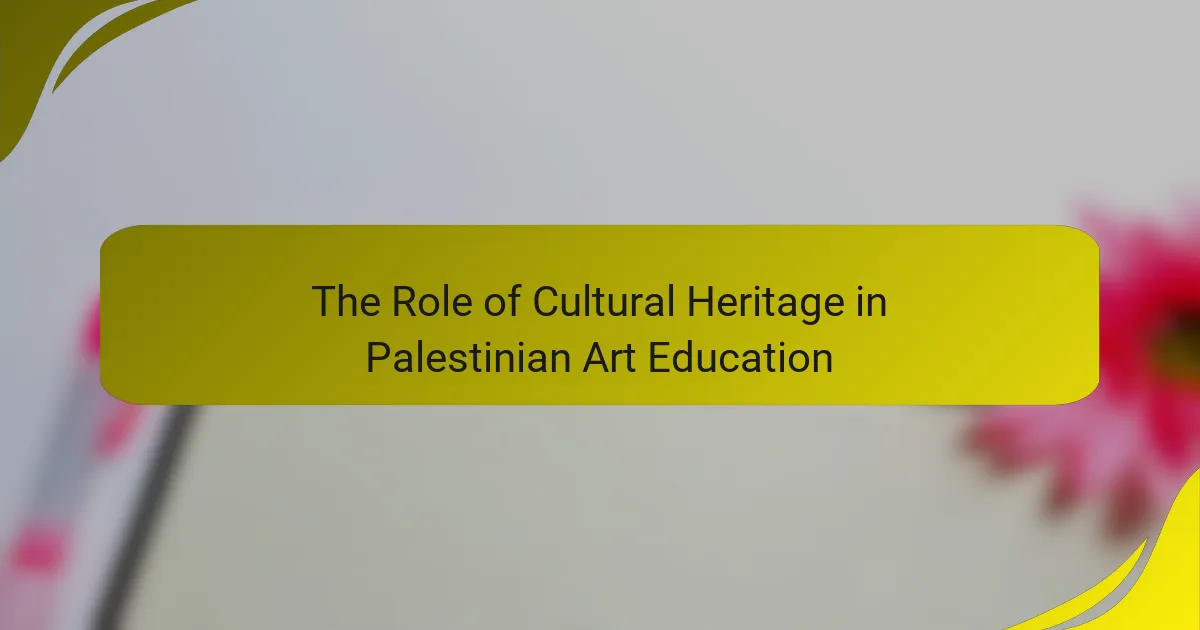Innovative teaching techniques in Palestinian art education focus on enhancing student engagement and learning outcomes through methods such as project-based learning, collaborative art projects, and community engagement initiatives. These techniques emphasize student-centered learning, interdisciplinary approaches, and technology integration, fostering critical thinking and artistic expression. Evidence suggests that hands-on experiences in art education deepen students’ understanding of cultural identity. The article explores how these innovative methods connect students with real-world issues and local cultural heritage, ultimately improving both artistic skills and cultural awareness.
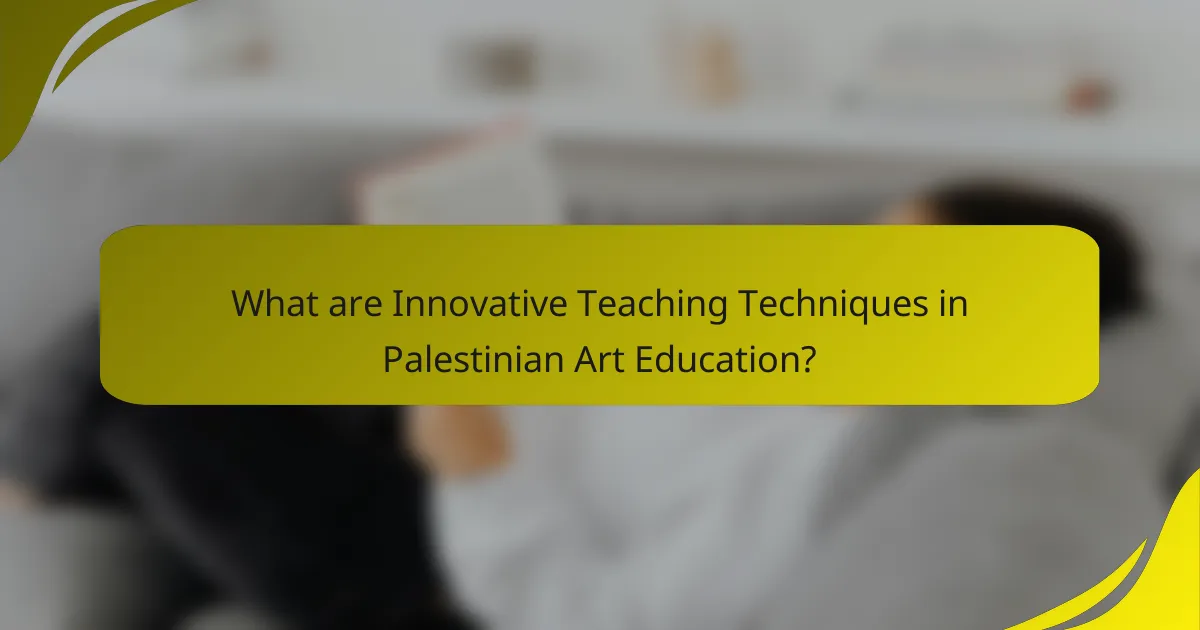
What are Innovative Teaching Techniques in Palestinian Art Education?
Innovative teaching techniques in Palestinian art education include project-based learning, collaborative art projects, and community engagement initiatives. Project-based learning allows students to explore real-world issues through art. Collaborative art projects foster teamwork and creativity among students. Community engagement initiatives connect students with local artists and cultural heritage. These techniques enhance critical thinking and artistic expression. Evidence shows that such methods improve student engagement and learning outcomes. Research indicates that hands-on experiences in art education lead to deeper understanding and appreciation of cultural identity.
How do these techniques differ from traditional methods?
Innovative teaching techniques in Palestinian art education differ from traditional methods by emphasizing student-centered learning. Traditional methods often focus on rote memorization and teacher-led instruction. In contrast, innovative techniques encourage creativity and critical thinking. They incorporate collaborative projects and hands-on experiences. This approach fosters a deeper engagement with the material. Research indicates that student-centered learning improves retention and understanding. A study by Hattie (2009) highlights that active learning strategies lead to higher achievement. Thus, these techniques enhance the educational experience compared to traditional methods.
What specific challenges do they address in Palestinian art education?
Palestinian art education addresses several specific challenges. These include limited resources for materials and facilities. Many schools lack adequate funding for art supplies and proper studio spaces. Additionally, there is a lack of trained art educators in the region. This shortage affects the quality of instruction students receive. Furthermore, political instability impacts the educational environment. Art programs often face interruptions due to conflict and restrictions. Cultural preservation is another challenge, as art education aims to maintain Palestinian heritage amidst ongoing changes. Lastly, there is a need for innovative teaching methods to engage students effectively. These challenges highlight the complexities faced in fostering a robust art education system in Palestine.
How do they incorporate local culture and history?
Innovative teaching techniques in Palestinian art education incorporate local culture and history through various methods. Educators use traditional Palestinian art forms, such as embroidery and pottery, to connect students with their heritage. Lessons often include historical narratives that highlight significant events and figures in Palestinian history. Workshops may feature local artists who share their experiences and techniques. Field trips to historical sites provide context and inspiration for students’ artwork. Collaborative projects with community members foster a sense of identity and belonging. These approaches ensure that students gain a deeper understanding of their cultural roots while developing their artistic skills.
Why are innovative teaching techniques important in this context?
Innovative teaching techniques are important in Palestinian art education because they enhance engagement and creativity. These methods foster critical thinking and problem-solving skills among students. Traditional approaches may not fully address the unique cultural and social contexts of Palestinian students. Innovative techniques can include collaborative projects, use of technology, and interdisciplinary learning. Research indicates that active learning strategies improve student retention and understanding. A study by Prince (2004) found that students in active learning environments outperform those in traditional settings. Therefore, implementing innovative techniques is essential for effective art education in Palestine.
What impact do they have on student engagement and creativity?
Innovative teaching techniques significantly enhance student engagement and creativity in Palestinian art education. These methods foster interactive learning environments. They encourage students to express their ideas freely. Research indicates that active participation boosts motivation. A study by Al-Hroub (2019) found that hands-on activities led to increased student interest in art. This engagement translates into higher creativity levels. Students exposed to innovative techniques demonstrate improved problem-solving skills. They also show greater willingness to experiment with various art forms. Overall, these techniques create a dynamic learning atmosphere that nurtures both engagement and creativity.
How do they contribute to the preservation of Palestinian art forms?
Innovative teaching techniques contribute to the preservation of Palestinian art forms by engaging students in traditional practices. These methods foster creativity through hands-on experiences with local art styles. They also emphasize the historical significance of Palestinian art in cultural identity. By integrating technology, educators can reach a wider audience, showcasing Palestinian art globally. Workshops and community projects encourage collaboration between artists and students. This active participation helps in passing down skills and knowledge to younger generations. Programs that highlight local materials and techniques ensure authenticity in art production. As a result, these educational approaches play a vital role in sustaining Palestinian artistic heritage.
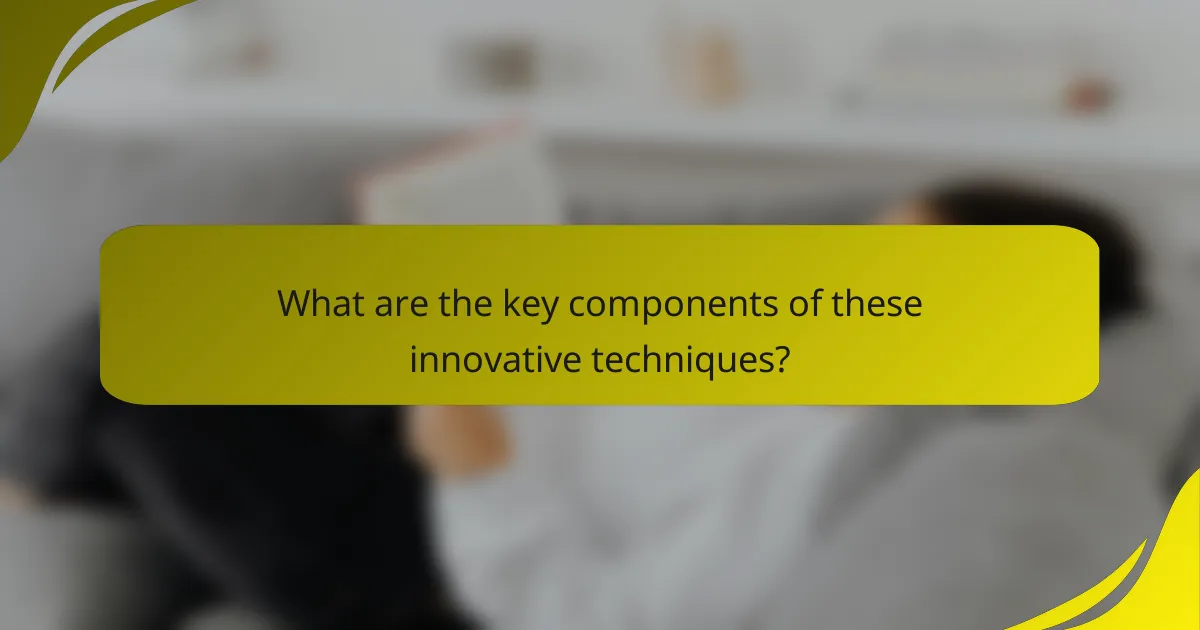
What are the key components of these innovative techniques?
The key components of innovative teaching techniques in Palestinian art education include student-centered learning, interdisciplinary approaches, and the use of technology. Student-centered learning emphasizes active participation and engagement. This method allows students to express their creativity and develop critical thinking skills. Interdisciplinary approaches integrate various subjects, enhancing the relevance of art education. For instance, combining history and art helps students understand cultural contexts. The use of technology facilitates access to diverse resources and encourages collaboration. Tools like digital art software and online platforms enable students to showcase their work globally. These components collectively foster a dynamic learning environment that nurtures artistic expression and cultural identity.
How do technology and digital tools enhance art education?
Technology and digital tools enhance art education by providing new methods for creativity and expression. They facilitate access to a wide range of resources and techniques. Digital platforms enable students to experiment with various art forms. Software programs allow for easy manipulation of images and designs. Online tutorials and courses increase learning opportunities beyond traditional classrooms. Virtual reality can simulate real-world art experiences, enhancing engagement. Research shows that students using technology in art education demonstrate improved skills and creativity. A study by the National Art Education Association found that integrating technology leads to higher student motivation and participation.
What types of digital tools are commonly used?
Commonly used digital tools in innovative teaching techniques include learning management systems, graphic design software, and virtual collaboration platforms. Learning management systems like Moodle and Google Classroom facilitate course organization and student engagement. Graphic design software such as Adobe Creative Suite enables students to create and edit visual art projects. Virtual collaboration platforms like Zoom and Microsoft Teams support real-time communication and project collaboration among students and instructors. These tools enhance the educational experience by promoting creativity, interaction, and accessibility in art education.
How do these tools facilitate collaboration among students?
These tools facilitate collaboration among students by providing platforms for communication and shared resources. They enable real-time interaction and feedback, enhancing group discussions. Features like document sharing allow students to co-create and edit projects simultaneously. Additionally, these tools often include discussion boards and chat functions for ongoing dialogue. They can also track contributions, ensuring accountability among group members. Studies show that collaborative tools improve engagement and learning outcomes. For instance, a study by Johnson & Johnson (2014) indicates that cooperative learning significantly enhances student achievement.
What role does community involvement play in these techniques?
Community involvement enhances innovative teaching techniques in Palestinian art education. It fosters collaboration between educators and local artists. This partnership enriches the curriculum with authentic cultural perspectives. Engaging the community also promotes resource sharing, such as materials and venues for exhibitions. Furthermore, community involvement encourages student participation in local art events. This active engagement helps students develop a sense of belonging and identity. Studies indicate that such involvement can improve student motivation and learning outcomes. Ultimately, community participation strengthens the educational framework and cultural relevance of art education in Palestine.
How can local artists contribute to the learning process?
Local artists can enhance the learning process by providing real-world insights and practical skills. They can conduct workshops that teach various artistic techniques. These workshops allow students to engage in hands-on experiences. Local artists can also share cultural narratives through their work. This helps students understand the historical context of art. Collaborations with local artists can foster community engagement. Research indicates that experiential learning improves retention rates. A study by the National Art Education Association shows that art education promotes critical thinking skills. Thus, local artists play a vital role in enriching educational experiences.
What are the benefits of community art projects for students?
Community art projects provide numerous benefits for students. They enhance creativity and self-expression. Students engage in collaborative work, fostering teamwork skills. Participation in these projects improves social awareness and cultural understanding. Research shows that students involved in community art experience increased motivation and academic engagement. A study by the National Endowment for the Arts found that arts participation correlates with higher academic performance. Additionally, these projects build a sense of belonging and community among students. They also offer opportunities for skill development in various artistic mediums. Overall, community art projects enrich the educational experience for students.

What are some examples of successful innovative teaching techniques in practice?
Project-based learning is a successful innovative teaching technique in practice. This method engages students in hands-on projects that connect art to real-world issues. For example, students might create art that reflects their cultural heritage. This fosters creativity and critical thinking. Collaborative learning is another effective technique. Students work together on art projects, enhancing communication skills. Technology integration also plays a key role. Using digital tools, students can explore new artistic mediums. These approaches have shown positive outcomes in student engagement and learning. Research indicates that such techniques improve both artistic skills and cultural awareness among students.
How have specific schools implemented these techniques?
Specific schools in Palestine have implemented innovative teaching techniques through project-based learning and community engagement. For example, Al-Quds University has introduced collaborative art projects that involve local artists. These projects encourage students to explore cultural identity through hands-on experiences. Additionally, the UNRWA schools have integrated technology into art education. They utilize digital tools to enhance creativity and accessibility. The success of these techniques is evident in improved student engagement and artistic expression. Reports indicate that students are more motivated and produce higher-quality work. These implementations reflect a commitment to modernizing art education in Palestinian schools.
What outcomes have been observed in these schools?
Outcomes observed in these schools include improved student engagement and creativity. Students demonstrate greater interest in art subjects. There is a noticeable increase in collaboration among peers. Academic performance in related subjects has also enhanced. Feedback from teachers indicates a positive shift in classroom dynamics. Students exhibit higher levels of self-expression through their artwork. Surveys show parents report increased enthusiasm for learning. Overall, innovative techniques have fostered a more supportive learning environment.
What feedback have students and teachers provided?
Students and teachers have provided diverse feedback on innovative teaching techniques in Palestinian art education. Students appreciate the hands-on approach and creative freedom offered in these methods. They report increased engagement and motivation in art classes. Teachers note improvements in student collaboration and critical thinking skills. They observe that innovative techniques foster a more inclusive classroom environment. Feedback indicates that students feel more connected to their cultural identity through these practices. Overall, both groups recognize the positive impact on learning outcomes and artistic expression.
What best practices can be drawn from these examples?
Best practices in innovative teaching techniques for Palestinian art education include fostering cultural relevance, encouraging collaboration, and integrating technology. Cultural relevance enhances student engagement by connecting lessons to students’ experiences. Collaboration among students promotes teamwork and diverse perspectives. Integrating technology, such as digital art tools, modernizes learning and appeals to digital natives. Evidence shows that culturally relevant pedagogy improves academic performance and student motivation. Studies indicate that collaborative projects enhance creativity and critical thinking skills. Furthermore, technology integration in education has been linked to increased student interest and participation.
How can other educators adapt these techniques to their own contexts?
Educators can adapt innovative teaching techniques by assessing their local educational contexts. They should identify the specific needs and cultural backgrounds of their students. Tailoring techniques to fit these needs ensures relevance and engagement. Collaboration with local artists can enhance the authenticity of the curriculum. Incorporating community resources allows for a richer learning experience. Additionally, educators can modify lesson plans based on available materials and technology. Ongoing professional development can provide insights into effective adaptations. Research indicates that contextually relevant teaching improves student outcomes and engagement.
What resources are available for teachers interested in innovative art education?
Teachers interested in innovative art education can access various resources. Online platforms offer lesson plans and teaching materials. Websites like ArtsEdge provide curriculum guides tailored for art educators. Professional organizations, such as the National Art Education Association, offer workshops and conferences. Additionally, social media groups facilitate collaboration among teachers. Art education journals publish research and innovative practices. Local art institutions often provide community engagement opportunities. These resources enhance teaching methods and foster creativity in art education.
How can educators effectively measure the success of these techniques?
Educators can effectively measure the success of innovative teaching techniques in Palestinian art education by utilizing a combination of assessments and feedback mechanisms. These can include pre- and post-assessments to evaluate student progress. Surveys and questionnaires can gather student feedback on their learning experiences. Observations during art sessions can provide qualitative insights into engagement and skill development. Additionally, portfolios showcasing student work can serve as tangible evidence of growth and mastery. Research indicates that formative assessments, which occur throughout the learning process, can significantly enhance educational outcomes. A study by Black and Wiliam (1998) in “Assessment and Classroom Learning” supports the effectiveness of ongoing assessments in improving student achievement.
What metrics should be used to evaluate student progress?
Standard metrics to evaluate student progress include grades, attendance, and participation. Grades provide a quantitative measure of student understanding and performance in assignments and tests. Attendance reflects student engagement and commitment to learning. Participation indicates active involvement in class discussions and activities. Additionally, formative assessments, such as quizzes and projects, offer insights into ongoing learning. Summative assessments evaluate cumulative knowledge at the end of a unit. Observations of student behavior and creativity in art projects also serve as qualitative metrics. These metrics combined create a comprehensive view of student progress and areas for improvement.
How can feedback from students enhance teaching methods?
Feedback from students enhances teaching methods by providing insights into their learning experiences. It allows educators to identify areas where students struggle. This information can guide adjustments to lesson plans and teaching styles. For instance, surveys and discussions can reveal students’ preferences and comprehension levels. Research shows that student feedback leads to improved engagement and academic performance. A study by Hattie and Timperley (2007) indicates that feedback is crucial for effective learning. By integrating student feedback, teachers can create a more responsive and effective learning environment. This ultimately fosters better educational outcomes in art education.
Innovative teaching techniques in Palestinian art education focus on enhancing student engagement and creativity through methods such as project-based learning, collaborative art projects, and community involvement. These techniques differ from traditional methods by prioritizing student-centered learning and hands-on experiences, addressing challenges like limited resources and political instability. The integration of local culture and history in art education, along with the use of technology and digital tools, further enriches the learning experience. Overall, these innovative approaches aim to improve artistic expression, critical thinking, and cultural identity among students in Palestine.
